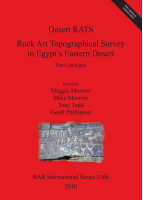Description
BOOK DESCRIPTIONWe are used to thinking of Egypt, ancient and modern, in terms of the Nile valley: well-watered, green and fertile, a narrow strip of life-sustaining land between vast tracts of hostile desert. But this accustomed view is an illusion: eventoday, the deserts of Egypt - which seem so inhospitable - support flora, fauna and people. In prehistoric times, the climate was wetter and life was much more abundant. The deserts' early inhabitants left behind images of their environment, lifestyle and deepest beliefs in the form of rock art, etched into the landscape. One of the biggest concentrations of this ancient, ancestral art is found to the east of the Nile, in the wadis (dry valleys) that dissect the hills and plains between the Wadi Hammamat to the north and the Wadi Barramiya to the south. In the space of just five months, between October 2000 and February 2001, three teams of dedicated volunteers carried out a systematic survey of this remarkable region. They succeeded in locating and recording over 100 new sites of rock art, previously unknown to archaeology. The results, comprising many thousands of individual scenes, are presented here for the first time. They open up a fascinating and largely unexpected window on Egypt's past, and on the beginnings ofcivilisation in north-eastern Africa. Hence, the present volume is, without doubt, an important contribution to an exciting new area of Egyptology. As always, new discoveries raise as many questions as they answer. The study of ancient Egyptian origins has been pursued for more than a century, yet many puzzles remain. For example, how and why did a great civilisation emerge in Egypt? Did the prehistoric inhabitants already share essentially the same culture, or did rival groups play a part in fashioning the distinctive Pharaonic tradition that we all recognise? The rock art of Egypt's Eastern Desert promises important new clues to these and other unsolved mysteries - clues that scholars will now have the chance to decipher and debate. Future generations of archaeologists and ancient historians will be thankful that the study of Egypt has enthusiasts as committed as the editors of this excellent survey report.











